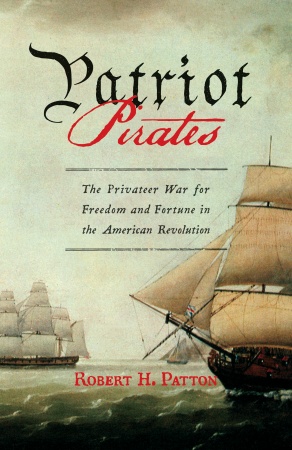
Patriot Pirates: The Privateer War for Freedom and Fortune in the American Revolution
by Robert H. Patton
The Revolutionary War used to leave Robert H. Patton cold.
Patton, scion of the famed military family, found the whole conflict lacking in “drama and palpable grit” until he discovered the privateers, “legalized pirates” who ransacked British ships for money, glory and country. Patton’s book focuses on the vast transcontinental web of business deals and intricate diplomacy of the privateers, rather than their derring-do at sea.
Privateers – with ships numbering in the several hundred, compared to ten official naval vessels in 1781 – won huge spoils for themselves and for the Continental army, often at the cost of imprisonment and death. Though exact numbers aren’t available, Patton notes that the postwar population of adult males in the biggest privateering counties were half the prewar number, and that the death toll was likely in the thousands, compared to the navy’s 832 dead.
Privateering struck many prominent Americans as depraved, and detrimental to the country – robbing the Continental navy of men by promising better wages and more lenient mores, encouraging a lust for private wealth over public interest. George Washington wanted only British military ships attacked, rather than merchant ones, and thought the whole privateer lot a disreputable bunch. John Paul Jones resented them, but briefly entertained the idea of building his own private fleet. (Benjamin Franklin and John Adams defended the practice and the men.) In any case, Patton argues, privateering sparked the cooperative spirit of American capitalism.
The privateers themselves – men well known and little known, whose fortunes swung wildly – are a fascinating bunch, intricately recreated by Patton. There are the boat captains like John Mugford, who captured the war’s richest ship, packed with arms, and John Manley, who served two years in prison under Britain’s harsh “Pirate Act.”
More detailed, though, are Patton’s tales of the major financiers behind the privateers (who were sometimes seafarers themselves). Major families were involved, like the Browns, their rivals the Greenes, and the Cabots, whose names decorate many American places today. There were also solo businessmen. William Bingham, for one, assembled a veritable fleet of privateers, many of them French, from his island post in Martinique. A single captured ship could yield Bingham over $250,000 in today’s dollars. Bingham’s sometime partner was Robert Morris, the “financier of the Revolution,” whose demands that Congress pay its bills encouraged unity among (and federal taxation of) the colonies. But Morris ended his life severely indebted and spent his elderly years in “near madness,” hiding “from gun-wielding creditors in the top floor of his mansion.”
Morris’ other partner, Silas Deane, had an even more fascinating trajectory: a blacksmith’s son who went to Yale, added an “e” to his last name for extra grandeur, and became an envoy to Paris. There, between living the high life and gallivanting with Edward Bancroft (a British double agent), he secured huge arms shipments for the American war effort and enlisted European soldiers of fortune. But, after failing to prove to Congress that he was owed money, he died broke in Britain, quite possibly poisoned by his old friend Bancroft in what Patton calls “a mercy killing.”
Personal fortunes and the economy sank after the war, and privateers weren’t well-remembered, if they were remembered at all, by official histories. But, as Patton writes, not only were privateers key to the war, but they were also key to the young country’s future, as they “accustom[ed] individualist Americans to financial partnerships and institutions. Thus national, state, and eventually private banks proliferated as the new century progressed.”
Excerpt: “At least one common sailor, Joseph Peabody, made the transition from teenage deckhand to privateer investor over the course of nine voyages between 1777 and 1783, initiating his rise toward becoming Salem’s largest magnate with eighty-three ships and eight thousand employees. And the lawyer John Lowell, originally of Newburyport, outearned his privateer clients through fees collected by brokering partnerships and helping to settle more than a thousand prizes. They were the Revolution’s nouveau riche, daring, grasping, brazen. Their future heirs would exemplify American old money at its most genteel.”
Further Reading: George Washington’s Secret Navy and If By Sea: The Forging of the American Navy -From the Revolution to the War of 1812




Send A Letter To the Editors